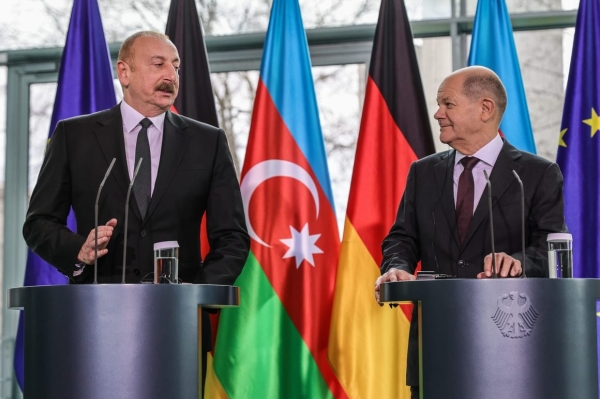Azerbaijan can become a constructive player in the Caucasus
The US, EU and Turkey must lead this mediation process, as they would directly benefit from a settlement that could foster security links and economic interconnectivity in the region.
Janusz Bugajski is a senior fellow at the Jamestown Foundation. His latest book is titled “Failed State: A Guide to Russia’s Rupture.”
Not all wars have to end in disaster alone. In fact, some can create conditions for more durable regional stability.
After Azerbaijan regained its occupied territories in a military offensive this September, following three decades of armed conflict with Armenia, the world is faced with the possibility of the country becoming a constructive player in the South Caucasus. However, in order to succeed, such a transformation would require much more coordinated involvement from the United States and the European Union.
The first priority, of course, would be to forge a comprehensive peace treaty between Armenia and Azerbaijan, with both parties vowing to recognize each other’s territorial integrity. The U.S., EU and Turkey must lead this mediation process, as they would directly benefit from such a settlement, which could foster security links and economic interconnectivity in the region.
While Russia and Iran have tried to monopolize the peace process thus far, the U.S. and the EU have been too passive in engaging Baku and Yerevan — despite the fact that both governments support American and European involvement.
Azerbaijan’s reconquest of Karabakh — a territory occupied by Armenia since the collapse of the Soviet Union — was a relatively swift operation. It resembled Croatia’s military operation in the summer of 1995, which saw the country regain territories occupied by Serbian paramilitaries, eventually launching it on a path toward EU and NATO membership.
According to reports by international organizations, including a United Nations mission, the Azeri military didn’t target civilians in Karabakh through ethnic cleansing, rather much of the exodus of the Armenian population — estimated at over 100,000 — was made up of evacuations or separatist leaders organizing citizens to leave. But as part of any future peace agreement, both Armenians and Azeris displaced by three decades of war must have the right of return to their ancestral lands.
An agreement to open the Zangezur-Syunik Corridor without violating Armenian sovereignty would also need to be urgently reached. If achieved, the road and rail connection between Azerbaijan and its exclave of Nakhichevan, next to the Turkish border, could become a valuable trade route, directly connecting the Caspian Basin with Turkey and NATO territory. It would also diminish Iranian influence in the region and enhance the West’s links with Central Asia.
Meanwhile, the Armenian government, disillusioned by Moscow’s inability to defend its traditional ally, would need to remove the remaining Russian bases on its territory, and Russia’s “peacekeepers” would need to exit Karabakh as well. Russia’s presence there has always been a recipe for division, and it obstructs both countries from moving closer to Western institutions.
Moreover, such moves by Yerevan would likely encourage Georgia to reclaim its Russian-occupied territories. And as Moscow weakens, Tbilisi could offer a looser federal arrangement to the separatist regions of Abkhazia and South Ossetia, while also attracting North Ossetia and other North Caucasus republics to move out of the increasingly obsolete Russian Federation’s sphere of influence.
Economic development across the Caucasus region could then be boosted by the development of trade ties between Baku and Yerevan, full diplomatic relations between Armenia and Turkey, and the design of a new regional development agenda. For example, opening new energy pipelines between the Caspian Sea and Turkey would particularly assist all regional economies, with Armenia no longer excluded from transit. And as an expanding energy and trade hub with intensified links to Europe and the U.S., Azerbaijan could help enhance Armenia’s economic development.
Such stability and cooperation would also bolster capital inflow and Western investment as the region seeks to wean itself off Russia, while ensuring protection from China’s economic dominance at the same time.
After 30 years of instability, this historical crossroads between the Black and Caspian seas now has the chance to tighten its political and economic links with the transatlantic world. However, Western governments need to be involved in helping reintegrate displaced populations in both Azerbaijan and Armenia, providing humanitarian assistance, mediating any latent disputes over borders, minorities or resources, and developing NATO’s security connections with both countries.
Ultimately, Russia and Iran — the two powers that thrive on regional conflict — will be the losers in the South Caucasus. And as Moscow forfeits its imperial possessions, becoming increasingly focused on internal turmoil in the North Caucasus, Azerbaijan will be able to campaign more effectively for the rights of its kindred population in Iran, which is estimated to be one-fourth of Iran’s total population.
Azerbaijan’s role as a regional stabilizer would also benefit U.S. interests, helping reduce the persistent threat of regional war, isolating Iran from the Caucasus, undercutting the Moscow-Tehran axis that generates conflict in the Middle East, and providing an alternative to China’s economic penetration. But without Western involvement, it’s unlikely such a transformation could come to life.






